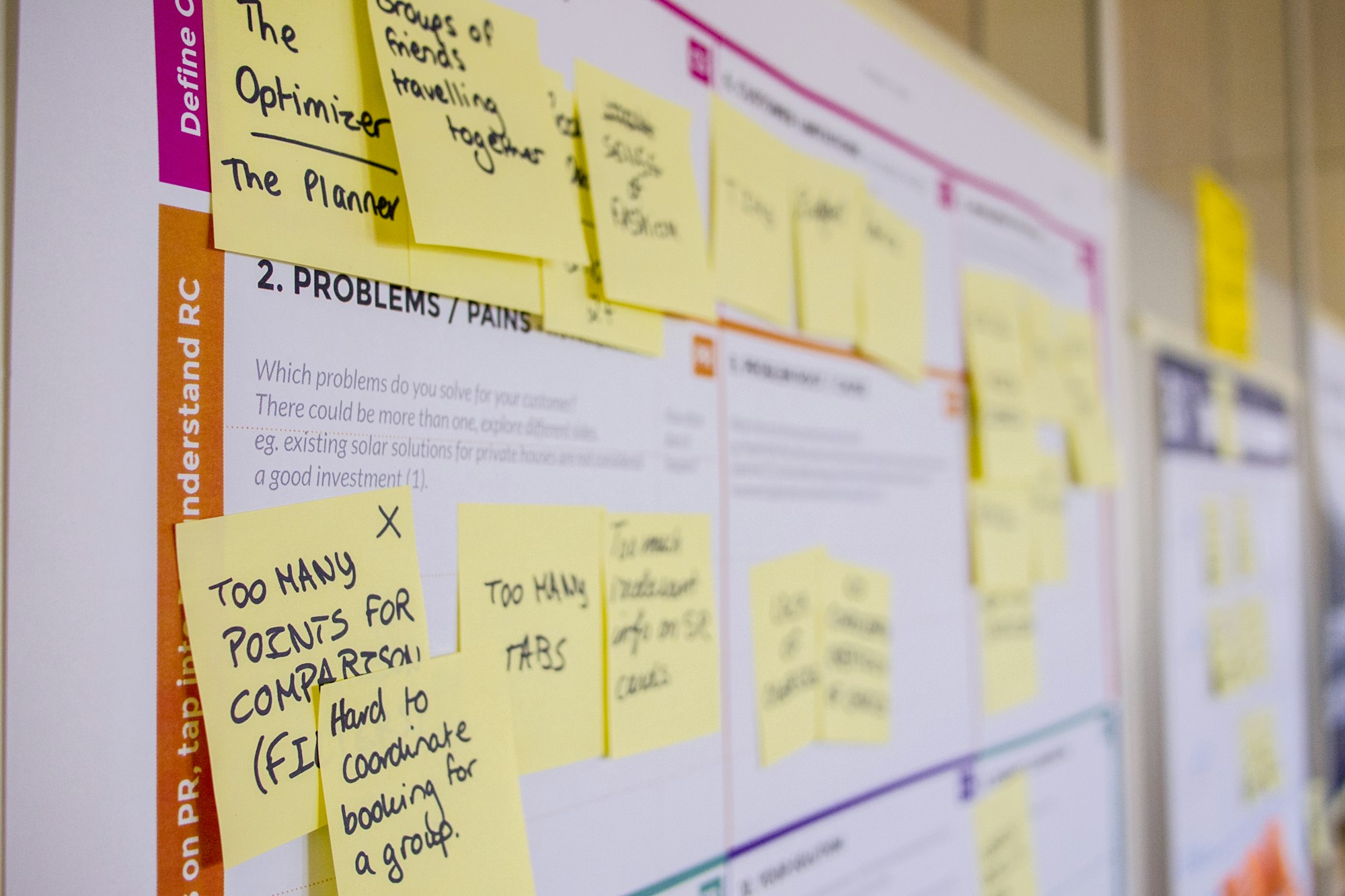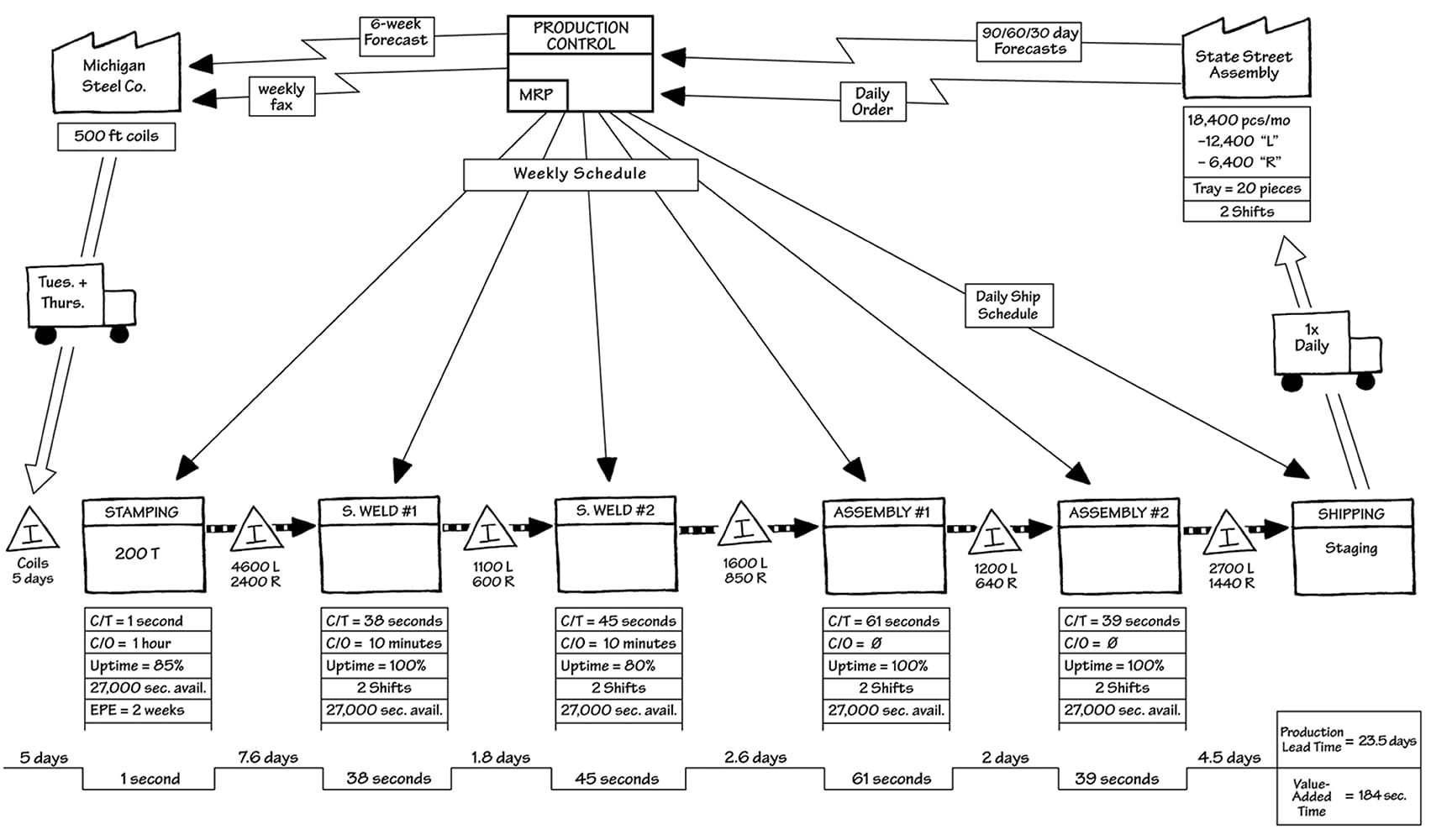Introduction
In residential construction, efficiency and process optimisation are not just buzzwords but essential practices for success. At the heart of these practices lies a tool known as Value Stream Mapping (VSM).
Originating from the manufacturing sector, VSM has found a significant place in the construction industry, particularly in larger projects. It's a visual tool that helps builders and project managers identify and eliminate waste, ensuring that every step adds value to the end product.
In this article, we will look into VSM, exploring its components, implementation in residential construction, and the myriad benefits it brings to the table.
Whether you’re a seasoned construction professional or new to the industry, understanding VSM can transform the way you manage and execute projects by giving you a new way to think about process and cycle optimisation.
What is Value Stream Mapping?
Value Stream Mapping is a lean-management method used for analysing and designing the flow of materials and information required to bring a product or service to a customer. At its core, VSM focuses on reducing waste within and between processes. It’s a visual representation that illustrates, analyses, and improves the steps involved in delivering a product or service.
Historical Background
VSM has its roots in the Lean Manufacturing principles developed in the Japanese automotive industry, particularly Toyota's production system. The primary goal was to identify and eliminate anything that doesn't add value, known as 'Muda' in Japanese. Over time, this concept has been adapted and applied across various industries, including construction.
Core Principles and Objectives
The central objective of VSM is to illustrate how work is done and to identify opportunities for making the process more efficient. It’s based on a few key principles:
- Identify Value: Understanding what the customer values is crucial. In residential construction, this might mean focusing on quality, speed, cost, or a combination of these factors.
- Map the Value Stream: This involves documenting all the steps required to deliver a project, from initial design to the final handover. It helps in visualising both value-adding and non-value-adding activities.
- Create Flow: After identifying the steps, the next step is to ensure they flow smoothly without interruptions. It’s about streamlining processes to reduce cycle times and improve efficiency.
- Establish Pull: This means ensuring that nothing is made ahead of time, minimising inventory and working in response to real customer demand.
- Seek Perfection: Continuous improvement is a key aspect of VSM. It involves regularly reviewing and refining processes to ensure they are as efficient as possible.
In the next section, we will delve into the main components of VSM and how they come together to create a comprehensive process map.
Main Components of VSM
Value Streams
The first component of VSM is the value stream itself. In the context of residential construction, this refers to all the activities and processes involved in constructing a home, from the initial planning and design stages to the final touches before handing over to the client. It’s crucial to differentiate between steps that add value from the client’s perspective and those that do not.
Flow
The concept of flow in VSM is pivotal. In construction, flow can be understood as the seamless transition of tasks and materials from one stage to the next, with minimal delays or bottlenecks. Achieving a smooth flow requires a deep understanding of each process and its dependencies. For example, ensuring that materials are delivered on time to avoid delays in the construction phase.
Waste Identification
Identifying and eliminating waste is a core objective of VSM. Waste in residential construction can manifest in various forms, such as excess inventory, overproduction, waiting time, unnecessary transportation, over-processing, defects, and underutilised talent. VSM helps in pinpointing these areas, allowing for targeted improvement efforts.
Process Variables
Process variables are the different factors that impact the efficiency and effectiveness of construction processes. These include the time taken for each task, the cost associated with each step, the quality of work, and the resources required. VSM helps in quantifying these variables, providing a clear picture of where improvements can be made.
Visualisation Tools
Visualisation is key in VSM. Flowcharts, process maps, and other visual tools are used to map out the entire construction process. This not only helps in understanding the current state but also aids in designing the desired future state where processes are more streamlined and efficient.
With these components in mind, the next section will guide you through implementing VSM in residential construction, providing a practical roadmap for enhancing process efficiency.
VSM in Residential Construction: A Step-by-Step Guide
Implementing Value Stream Mapping in the residential construction process involves several key steps. This guide will walk you through each phase, offering insights and practical tips for effective implementation.
1. Team Formation and Training
Start by assembling a cross-functional team. This team should include representatives from various departments such as design, procurement, construction, and quality control. Training the team in VSM principles is crucial for ensuring everyone is on the same page.
2. Define the Scope and Objectives
Clearly define what you want to achieve with VSM. Are you looking to reduce construction time, minimise costs, improve quality, or all of the above? Setting clear objectives guides the focus of your mapping efforts.
3. Map the Current State
Begin by mapping out the current state of your construction process. Document every step, from initial client consultation to final delivery. This map should include details such as the duration of each step, the resources involved, and any waiting times or delays.
4. Identify and Categorise Waste
With the current state map in hand, identify areas of waste. These could be steps that do not add value from the client’s perspective or processes that could be more efficient. Categorise these wastes according to common types, such as overproduction, defects, or unnecessary movements.
5. Design the Future State
Based on the insights gained from the current state map, design a future state that eliminates identified wastes and optimises the flow of processes. This might involve re-sequencing steps, introducing new technologies, or changing how resources are allocated.
6. Develop an Implementation Plan
Create a detailed plan for transitioning from the current state to the desired future state. This plan should include specific actions, timelines, and responsibilities. It’s important to set realistic goals and consider potential obstacles.
7. Implement and Monitor
Begin implementing the changes according to your plan. Monitor the process closely to ensure that the changes are having the desired effect. Use key performance indicators (KPIs) to measure progress.
8. Continuous Improvement
VSM is not a one-time activity but an ongoing process of improvement. Regularly review and update your value stream maps to reflect changes in your processes or objectives.
Benefits of Using VSM in Residential Construction
The adoption of Value Stream Mapping in residential construction brings a multitude of benefits, significantly enhancing project management and execution. Below are some of the key advantages:
1. Enhanced Efficiency and Reduced Lead Times
By streamlining processes and eliminating waste, VSM helps in significantly reducing the time from project inception to completion. This improved efficiency can lead to faster project turnaround times, allowing construction firms to take on more projects and increase profitability.
2. Cost Reduction
Identifying and eliminating wasteful steps leads to a more cost-effective operation. Savings can come from reduced material waste, more efficient use of labour, and decreased need for rework. These cost savings can either boost profit margins or be passed on to clients, enhancing competitive advantage.
3. Improved Quality
VSM facilitates a better understanding of each process and its impact on the final product. This clarity helps in maintaining high-quality standards throughout the construction process, resulting in a better end product and higher client satisfaction.
4. Enhanced Client Satisfaction
With VSM, construction processes become more predictable and transparent, which can significantly improve client satisfaction. Clients appreciate timely delivery and quality work, both of which are facilitated by an efficient value stream.
5. Better Resource Utilisation
VSM promotes the optimal use of resources, including materials, labour, and equipment. This not only reduces costs but also minimises the environmental impact, contributing to sustainable construction practices.
6. Facilitates Continuous Improvement
VSM is not a static process; it encourages continuous review and improvement. This culture of ongoing enhancement ensures that construction processes remain efficient and adaptable to changing market demands or construction technologies.
Software Tools for Implementing VSM in Residential Construction
In today's digital age, various software tools have been developed to aid in the effective implementation of Value Stream Mapping, especially in complex sectors like residential construction. These tools not only simplify the creation of value stream maps but also enhance the analysis and monitoring of processes. Below, we explore some of the key software solutions available:
1. LeanKit
LeanKit is a visual project management tool that aligns with Lean principles. It offers a flexible platform for creating value stream maps and tracking progress in real time. With its intuitive drag-and-drop interface, construction managers can easily visualise workflows, identify bottlenecks, and manage resources effectively.
2. Lucidchart
Lucidchart is a versatile diagramming tool that is well-suited for creating detailed VSM diagrams. Its user-friendly interface allows for easy mapping of construction processes, and its collaboration features enable teams to work together seamlessly, regardless of their location.
3. Minitab
While Minitab is primarily known for its statistical analysis capabilities, it also offers tools for process mapping and improvement. Its strength lies in data analysis, which can be critical in identifying trends and areas for improvement in construction processes.
4. Microsoft Visio
A part of the Microsoft Office suite, Visio is a powerful tool for creating complex diagrams, including value stream maps. It’s particularly useful for construction professionals who are already familiar with other Microsoft products, allowing for easy integration and data sharing.
5. iGrafx
iGrafx provides a comprehensive suite of business process management tools. Its capabilities in process modelling and analysis make it a strong contender for implementing VSM in construction. It helps in not only mapping but also in simulating changes to predict outcomes.
6. eVSM
eVSM is specifically designed for value stream mapping and lean management. Its focused approach on VSM makes it a popular choice among professionals looking to dive deep into process optimisation.
Each of these tools offers unique features and benefits. The choice depends on the specific needs of the construction project, the scale of operations, and the level of detail required in the value stream mapping.
Advanced Topics in VSM and its Role in Residential Construction
VSM and Lean Construction Principles
Value Stream Mapping is intricately linked to Lean Construction, a method that emphasises minimising waste and maximising value. VSM, as a core component of Lean Construction, helps in visualising and improving construction processes. It aligns perfectly with Lean principles like 'Just-In-Time' production and 'Kaizen' or continuous improvement, making it an indispensable tool for Lean practitioners in the construction sector.
Advanced VSM Techniques
As VSM evolves, several advanced techniques have emerged. These include:
- Digital VSM: Leveraging digital tools for more dynamic and interactive value stream maps. This approach allows for real-time updates and better collaboration among teams.
- Integrating VSM with BIM (Building Information Modelling): Combining VSM with BIM technology enables a more holistic view of the construction process, from design to execution, enhancing efficiency and accuracy.
Future Trends in VSM in Construction
The future of VSM in residential construction looks towards greater integration with technology. Some of the emerging trends include:
- AI and Machine Learning: Utilising AI to analyse large sets of process data, predict potential delays or problems, and recommend optimisations.
- IoT Integration: Using Internet of Things (IoT) devices for real-time tracking of materials and equipment, feeding valuable data into the value stream map.
- Sustainability Focus: Incorporating environmental and sustainable practices into VSM, aligning construction processes with eco-friendly standards.
These advancements are setting the stage for a more efficient, responsive, and sustainable construction industry. VSM, when combined with these technological innovations, has the potential to revolutionise residential construction processes, delivering projects that are not only cost-effective but also high in quality and sustainable.
Conclusion
Value Stream Mapping is more than just a tool; it's a mindset that can revolutionise the residential construction process. By emphasising efficiency, waste reduction, and continuous improvement, VSM aligns perfectly with the dynamic needs of the construction industry.
Whether you're a project manager, a construction professional, or a process improvement enthusiast, embracing VSM can lead to significant improvements in project delivery, cost management, and client satisfaction. As the construction industry continues to evolve, integrating VSM into your processes can be a game-changer, setting the stage for success in an increasingly competitive market.
Key Takeaways
- VSM Enhances Efficiency: It streamlines construction processes, reducing lead times and improving project turnaround.
- Cost Reduction: VSM identifies waste, leading to cost-effective operations and potentially higher profit margins.
- Improves Quality: A focus on value-adding steps ensures higher quality in construction projects.
- Client Satisfaction: Efficient and transparent processes lead to increased client trust and satisfaction.
- Resource Optimisation: VSM promotes sustainable use of materials and labour.
- Continuous Improvement Culture: Regular VSM reviews foster a culture of ongoing enhancement and adaptation.
- Technology Integration: The use of digital tools and software in VSM is becoming increasingly important, offering real-time insights and collaboration opportunities.
Frequently Asked Questions
Q: Can VSM be applied to small-scale residential construction projects?
A: Absolutely. VSM is scalable and can bring significant benefits even to smaller projects by identifying inefficiencies and areas for improvement.
Q: How long does it take to see results after implementing VSM?
A: Results can vary, but typically, some improvements can be noticed within a few weeks to months, especially in areas like reduced waiting times and improved workflow.
Q: Is special training required to implement VSM?
A: While basic knowledge of VSM principles is beneficial, many of the software tools available today are user-friendly and designed for those new to VSM.
Q: How frequently should value stream maps be updated?
A: It's good practice to review and update them regularly, such as after the completion of a project, to reflect any process changes or improvements.


















